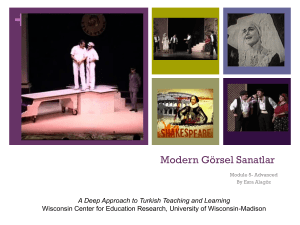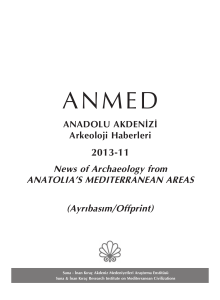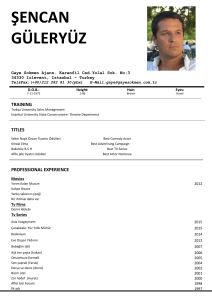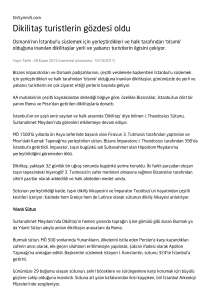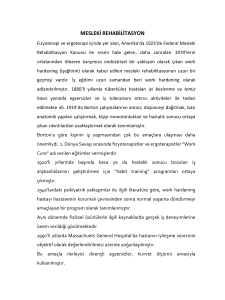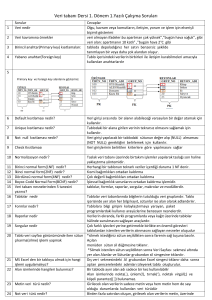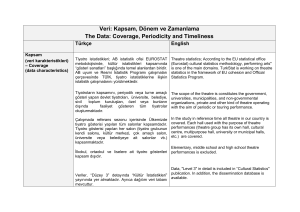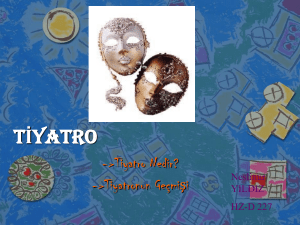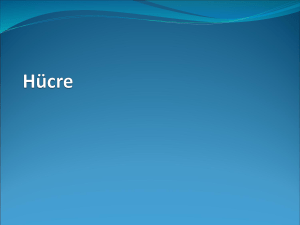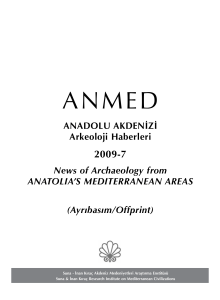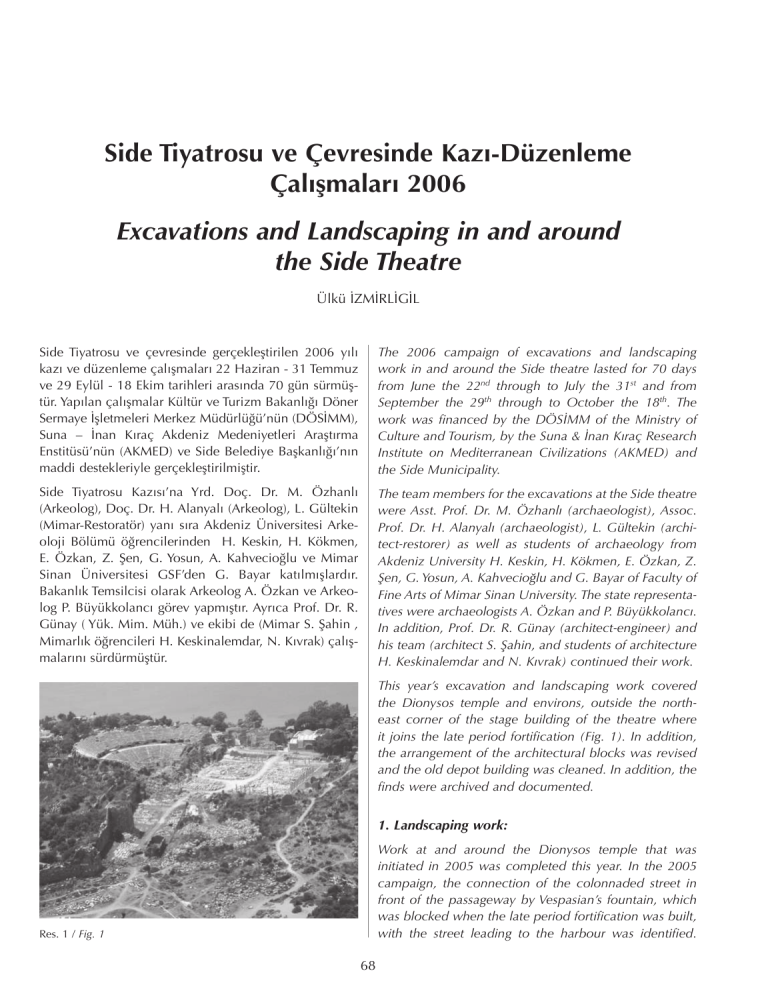
Side Tiyatrosu ve Çevresinde Kazı-Düzenleme
Çalışmaları 2006
Excavations and Landscaping in and around
the Side Theatre
Ülkü İZMİRLİGİL
Side Tiyatrosu ve çevresinde gerçekleştirilen 2006 yılı
kazı ve düzenleme çalışmaları 22 Haziran - 31 Temmuz
ve 29 Eylül - 18 Ekim tarihleri arasında 70 gün sürmüştür. Yapılan çalışmalar Kültür ve Turizm Bakanlığı Döner
Sermaye İşletmeleri Merkez Müdürlüğü’nün (DÖSİMM),
Suna – İnan Kıraç Akdeniz Medeniyetleri Araştırma
Enstitüsü’nün (AKMED) ve Side Belediye Başkanlığı’nın
maddi destekleriyle gerçekleştirilmiştir.
The 2006 campaign of excavations and landscaping
work in and around the Side theatre lasted for 70 days
from June the 22nd through to July the 31st and from
September the 29th through to October the 18th. The
work was financed by the DÖSİMM of the Ministry of
Culture and Tourism, by the Suna & İnan Kıraç Research
Institute on Mediterranean Civilizations (AKMED) and
the Side Municipality.
Side Tiyatrosu Kazısı’na Yrd. Doç. Dr. M. Özhanlı
(Arkeolog), Doç. Dr. H. Alanyalı (Arkeolog), L. Gültekin
(Mimar-Restoratör) yanı sıra Akdeniz Üniversitesi Arkeoloji Bölümü öğrencilerinden H. Keskin, H. Kökmen,
E. Özkan, Z. Şen, G. Yosun, A. Kahvecioğlu ve Mimar
Sinan Üniversitesi GSF’den G. Bayar katılmışlardır.
Bakanlık Temsilcisi olarak Arkeolog A. Özkan ve Arkeolog P. Büyükkolancı görev yapmıştır. Ayrıca Prof. Dr. R.
Günay ( Yük. Mim. Müh.) ve ekibi de (Mimar S. Şahin ,
Mimarlık öğrencileri H. Keskinalemdar, N. Kıvrak) çalışmalarını sürdürmüştür.
The team members for the excavations at the Side theatre
were Asst. Prof. Dr. M. Özhanlı (archaeologist), Assoc.
Prof. Dr. H. Alanyalı (archaeologist), L. Gültekin (architect-restorer) as well as students of archaeology from
Akdeniz University H. Keskin, H. Kökmen, E. Özkan, Z.
Şen, G. Yosun, A. Kahvecioğlu and G. Bayar of Faculty of
Fine Arts of Mimar Sinan University. The state representatives were archaeologists A. Özkan and P. Büyükkolancı.
In addition, Prof. Dr. R. Günay (architect-engineer) and
his team (architect S. Şahin, and students of architecture
H. Keskinalemdar and N. Kıvrak) continued their work.
This year’s excavation and landscaping work covered
the Dionysos temple and environs, outside the northeast corner of the stage building of the theatre where
it joins the late period fortification (Fig. 1). In addition,
the arrangement of the architectural blocks was revised
and the old depot building was cleaned. In addition, the
finds were archived and documented.
1. Landscaping work:
Work at and around the Dionysos temple that was
initiated in 2005 was completed this year. In the 2005
campaign, the connection of the colonnaded street in
front of the passageway by Vespasian’s fountain, which
was blocked when the late period fortification was built,
with the street leading to the harbour was identified.
Res. 1 / Fig. 1
68
KAZI RAPORLARI
EXCAVATION REPORTS
Bu yıl kazı ve düzenleme çalışmaları Dionysos Tapınağı ve çevresinde, tiyatro sahne binasının kuzey-doğu
dış köşesinde, Geç Dönem suru ile birleştiği bölümde
sürdürülmüştür (Res. 1). Ayrıca, bu alanda mimari blok
düzenlemeleri yeniden ele alınmış ve eski depo binası
temizlenmiştir. Bunun yanı sıra buluntuların arşivleme
ve belgeleme çalışmaları yapılmıştır.
1. Düzenleme Çalışmaları:
2005 yılında başlamış olan Dionysos Tapınağı ve çevresindeki çalışmalar bu yıl tamamlanmıştır. 2005 yılında tapınağın ön tarafında yapılan kazıda, Vespasian
Çeşmesi’nin yanında yer alan ve daha sonra Geç Dönem
suru yapıldıktan sonra kapatılmış olan geçidin önünde
bulunan portikli yolun limana giden cadde ile bağlantısı
tespit edilmiştir. Antik Dönem’de kente girişi sağlayan
bu geçit, yeni bir düzenlemeyle açılarak Side’nin yoğun
yaya trafiği sorununa çözüm getirmiştir.
Res. 2 / Fig. 2
This passageway, which provided access into the city in
Antiquity was reopened and brought a solution to the
extensive pedestrian traffic at Side.
Bu yıl yaya trafiğine açılmış olan geçitten geçen yayaların tiyatroya daha rahat girebilmeleri için, caddenin
sol tarafındaki portikde sıralanan blokların daha geriye
alınmasıyla bu alan da yaya trafiğine açılabilmiştir.
Portikli caddenin sağ tarafındaki sütunlardan bazıları
kazı sonrası onarılıp ayağa kaldırılmış, ancak sol tarafta
sadece tiyatro girişinin önünde iki tane sütun dikilmişti.
tiyatronun E galerisi hizasında daha önce bloklar altında
kalmış olan stylobatın sağlam durumda olması bir sütunun daha ayağa kaldırılmasına olanak sağlamıştır.
This year, to facilitate pedestrian access to the theatre via
the newly reopened passageway the blocks lying by the
portico on the left of the street were moved somewhat
further back and this area was also opened to pedestrian
traffic. Some of the columns on the right side of the colonnaded street were repaired and re-erected after the
excavations, but on the left side, only two columns were
re-erected in front of the theatre’s entrance. The fact that
the stylobate previously concealed beneath the blocks
by gallery E of the theatre was well-preserved permitted
the re-erection of another column.
Tapınağın çevresindeki çalışmalar tamamlandıktan
sonra, 2001 yılı kazı döneminde Yrd. Doç. Dr. M.
Büyükkolancı’nın batı paradosda yaptığı kazı çalışmaları
sırasında Dionysos Tapınağı’na ait olduğunu belirlediği
mimari parçalar tapınağın üzerine taşınarak yapının
mimarisini gösterecek şekilde düzenlenmiştir (Res. 2 ).
When the work around the temple was completed,
the architectural pieces identified as belonging to the
Dionysos temple by Asst. Prof. Dr. M. Büyükkolancı
during his excavations of the west parodos in 2001 were
moved inside the temple and were arranged to show the
architecture (Fig. 2).
2. Kazı Çalışmaları:
2. Excavations:
Tiyatro’nun kuzey-doğu köşesini oluşturan dış galeri
ayağının (Z) üst kısmı kütle halinde arkaya devrilmiştir.
Sahnenin dış duvarı ise geç dönemde sur duvarı ile birleştirilerek bir bütün haline getirilmiştir. Burada yapılan
kazının amacı, tiyatronun özgün yapısı ile geç dönem
suru arasındaki bağlantıyı saptamaktır.
The upper part of the outer gallery pier Z forming the
northeast corner of the theatre had fallen as a mass
behind and the exterior wall of the stage was incorporated into the late period fortification wall. The excavations here aimed at clarifying the connection between
the original construction of the theatre and the late
period wall.
Bu alanda yoğun taş blok yıkıntının kazısına başlamadan
önce, çıkacak çok sayıda bloğun belirlenmiş olan bir
yerleşme alanı düzeni içinde gruplanması gerektiğinden
uzun süren bir ön hazırlık çalışması yapılmıştır. Çalışma
alanında önce 12-13 m. yüksekliğindeki yıkıntının taşları alınmaya başlanmıştır. Bu bölümdeki şekilsiz konglomera ve traverten bloklar 16 numaralı genel taş alanına
Preparations before starting the excavations in the extensive heap of stone blocks lasted for a very long time as
the large number of blocks that would be uncovered
needed to be arranged in an order within a defined area.
In the work area, firstly the stone blocks from the heap
69
KAZI RAPORLARI
EXCAVATION REPORTS
aktarılmıştır. Tiyatroya ait oturma sıraları, profil veren
yapı elemanları, mermer arşitrav parçaları ve diğer yapı
elemanları (131 adet ) numaralandıktan sonra, 21 ve 34
numaralı alanlara taşınmıştır (Plan 1).
12-13 m. high were removed. The amorphous conglomerate and travertine blocks were taken to the general
stone area no. 16. A total of 131 pieces containing rows
of seats from the theatre, structural elements with profile,
marble architrave pieces and other structural elements
were numbered and taken to areas nos. 21 and 34
(Plan 1).
Kazı ilerledikçe, en üst seviyeden yaklaşık 2 m. aşağıda
tiyatronun dış galeri ayağı (Z) ile sahne binası arasındaki
duvar boyunca 0.32 m. genişliğinde 0.37 m. derinliğinde içi sıvalı bir su kanalı ortaya çıkmıştır (Res. 3). Bu
kanal duvar boyunca yaklaşık 12 m. düz devam ederek
sahne binasının arkasına doğru kıvrıldığı, ancak yıkıntı
sırasında hasar gördüğü anlaşılmıştır. Kanalın, tiyatronun doğudaki son dış galeri ayağı etrafında dolanıp sur
duvarından içeri girdiği izlenmiştir. Ancak arka kısmının
kapalı olması geç dönem suru yapıldıktan sonra kullanılmadığını düşündürmektedir.
As the excavation progressed, at about 2 m. below the
top level, a plastered water canal of 0.32 m. wide and
0.37 m. deep was uncovered along the wall between the
outer gallery pier Z and the stage building (Fig. 3). It was
seen this canal continued for about 12 m. along the wall
and then turned to the back of the stage building but it
was damaged when this area collapsed. The canal was
traced and it was observed that it enter inside through
the fortification wall after going round the last outer gallery pier on the east. However, as its rear side is closed,
it is thought not to have functioned after the late period
fortification wall was built.
Dış galeri ayağının iç köşesinde kanalın önünde, daha
alt seviyede, 1.25 m. genişliğinde pişmiş toprak levha
kaplı bir döşeme yapılmış ve döşemenin bittiği yerde
birinci kanala dik açıyla gelen 0.42 m. genişliğinde
0.70 m. derinliğinde kuzeye doğru devam eden ikinci
bir kanal tespit edilmiştir. Ancak bu kanalın ana kanal
ile bağlantısı bulunmamaktadır. Bu alanda; latrin’le
sahne binasının agora cephesindeki dükkanlar üzerinde
su künkleri ve oluk izlerinin, su kanalı ile bağlantısının
incelenmesi gerekmektedir (Res. 4).
On the inner corner of the outer gallery pier, in front of
the canal but at a lower level was a pavement of baked
clay plaques 1.25 m. wide and, a second canal 0.42 m.
wide and 0.70 m. deep, extending to the north and at a
right angle to the first canal was found where this pavement ends. However, this canal does not have any connection to the main canal. It is now necessary to explore
the water pipes and canals to the latrines and shops on
the agora’s facade and their connection to the water
canal (Fig. 4).
Agoradan M yapısına giden portikli yolun başlangıcındaki doğu kapısı ile yığıntı arasındaki alanda yapılan kazı
çalışmalarında kapı ve caddenin başlangıcı tamamen
açılmıştır. Caddenin altından geçen kanalizasyon yukarıdan düşen bloklarla içe göçmüş ve zemin döşemesi
kırılmıştır (Res. 5).
Lejand:
A- Tiyatro, sahne binası cephesi I. II. ve III. kat arşitrav-friz
bloğu grubu.
B- Agoraya ait granit sütun ve granit sütun parçaları grubu
C- Tiyatro, sahne binasına ait granit sütun ve granit sütun
parçaları grubu.
D- Dionysos tapınağı mimari elemanları grubu
E- Tiyatro, sahne binasına ait kasetler ve kaset parçaları grubu
F- Tiyatro, sahne binası II. ve III. kata ait mermer sütun ve
mermer sütun parçaları grubu
G- Tiyatro, sahne binasına ait geison ve geison parçaları grubu
H- Tiyatro, sahne binasına ait alınlık-sima ve
alınlık-sima parçaları grubu
I- Tiyatro, sahne binası cephesi I. kat ion sütun başlıkları grubu
J- Tiyatro, sahne binası cephesi korint sütun başlıkları grubu
K- Tiyatro, sahne binası cephesi kompozit sütun başlıkları grubu
L- Tiyatro, sahne binası sütun kaideleri grubu
M- Tykhe tapınağı mimari elemanları grubu
Z1- Tiyatro, sahne binası, karışık durumda iki mimari elemanlar
topluluğu (büyük boy)
Z2- Tiyatro, sahne binası, karışık durumdaki mermer elemanlar
topluluğu (küçük boy)
Plan 1
70
KAZI RAPORLARI
EXCAVATION REPORTS
Res. 3 / Fig. 3
Res. 4 / Fig. 4
Doğu kapısı ile tiyatro arasında yapılan çalışmalarda,
eksedradan 3.75 m. mesafede 2.66 m. genişliğinde
ikinci bir kapı açığa çıkarılmıştır (Plan 2). Geçidin iç
kısmında büyük parçalar halinde yıkılmış olan tuğla
tonoz parçaları çökmüş bulunmaktaydı. M binasına
giden yolun söz konusu kapının kuzey tarafında belirli aralıklarla yerleştirilmiş postamentler in situ olarak
bulunmuştur. Kapıdan sonraki ikinci postament üzerinde
duran beyaz mermer sütun kaidesi kırılarak öne, üzerinde yer alan sütun ise aksi yöne doğru düşmüş halde
bulunmuştur. Portiğin sütun kaideleri M binasına kadar
belli aralıklarla yer almaktadır. Kapının sol tarafında
doğu kapısına 1.10 m. aralıklı, 1.14 m. genişliğinde
küçük taşlardan örülü ikinci bir duvar bulunmaktadır.
Excavations in the area between the heaps of rubble
and the east gate at the beginning of the colonnaded
street leading to the structure M from the agora, entirely
exposed the gate and the beginning of the street. The
sewage canal under the street caved in when the blocks
collapsed upon it and its flooring was broken (Fig. 5).
The work in the area between the east gate and the
theatre exposed a second gate which is 3.75 m. from
the exedra and is 2.66 m. wide (Plan 2). Inside its passageway were rubbles of brick vaulting lying in large
lumps. To the north of this second gate, along the street
leading to the structure M were found postaments in situ
at regular intervals. The broken white marble base on the
second postament after the gate fell forwards while its
column fell behind. The column bases of the colonnade
are found at regular intervals up to structure M. To the
left of the gate, 1.10 m. away from the east gate, there
is a second wall of small stones 1.14 m. wide. During
the levelling work in the street, at the line of the second
Plan 2
Res. 5 / Fig. 5
71
KAZI RAPORLARI
EXCAVATION REPORTS
Cadde üzerinde yapılan tesviye çalışmalarında ise ikinci
postament hizasında caddenin orta kısmında bir arada
duran on adet unguentarium ve bronz bir kemer tokası
bulunmuştur. Ayrıca tuğlalı tonozun ön kısmında 14 cm.
yüksekliğinde başı eksik ve yüzeyi aşınmış mermer bir
büst açığa çıkarılmıştır.
postament ten unguentaria and a bronze belt buckle
were found together. In addition, in front of the brick
vaulting, a worn marble bust 14 cm. high, with missing
head, was found.
3. Archiving and documentation work:
This work included drawing the architectural elements
of the Dionysos temple and double-checking the measurements of the agora and theatre. The baked clay
shards uncovered in previous campaigns as well as in
this year’s work were grouped systematically, drawings
were made and files were prepared and the other items
of metal, stone, baked clay and glass were also photographed and archived.
3. Arşivleme ve Belgeleme Çalışmaları:
Bu çalışmalar kapsamında Dionysos Tapınağı’nın mimari
elemanlarının çizimi ve agora ile tiyatronun ölçülerinin
kontrolü yapılmıştır. Ayrıca geçen senelerde ve bu sene
açığa bulunan pişmiş toprak çanak çömlek parçalarının
sistemli ayırımlarının, çizimlerinin yapılması ve dosyalarının hazırlanması, taş, maden, pişmiş toprak, cam gibi
etüdlük malzemenin fotoğrafları da çekilerek arşivlenmesi gerçekleştirilmiştir.
The coffers of the stage building and podium frieze
fragments uncovered in previous years were checked
by Assoc. Prof. Dr. H. Alanyalı and the photographic
archives were revised and rearranged.
Daha önceki yıllarda bulunmuş olan tiyatro sahne binası
kasetleri ile podyum frizi parçalarının kontrolleri Doç.
Dr. H. Alanyalı tarafından yapılmış ve fotoğraf arşivleri
yeniden gözden geçirilerek düzenlenmiştir.
Prof. Dr. R. Günay and his team continued their work
with AutoCAD and the crosschecking and recording of
relevé measurements.
Ayrıca Prof. Dr. R. Günay ve ekibi tarafından AutoCAD
programı ile rölöve ve kontrol ölçülerine devam edilmiştir.
4. Cleaning of the Depot Building:
The depot building was built for the theatre in the 1960’s
by UNESCO but was in a poor state, its roof had fallen
and here cleaning work was initiated. This building was
repaired for the systematic storage of the archaeological items uncovered and to house the other materials
employed during the excavations.
4. Depo Binasının Temizlenmesi:
UNESCO tarafından 1960’lı yıllarda tiyatro için yapılmış olan çatısı çökmüş depo binasının içinde temizlik
çalışmaları yapılmıştır. Alandaki çalışmalar sırasında
kullanılan malzemenin ve açığa çıkan etütlük arkeolojik
malzemelerin sistemli bir şekilde depolanabilmesi için
bu binanın onarımı gerekmektedir.
72

